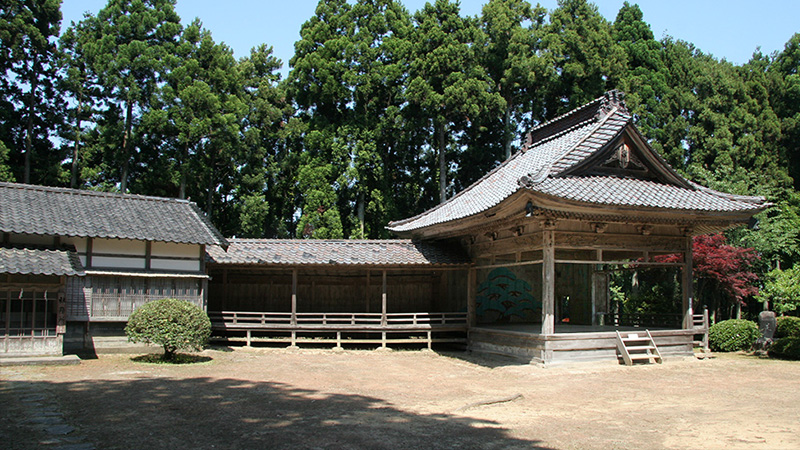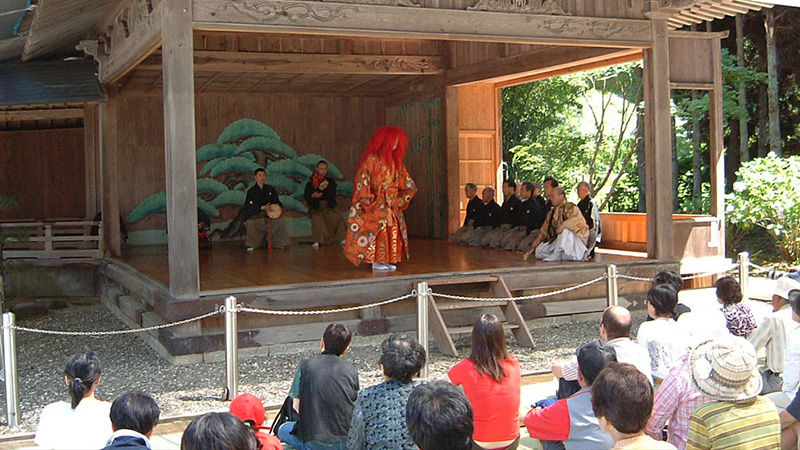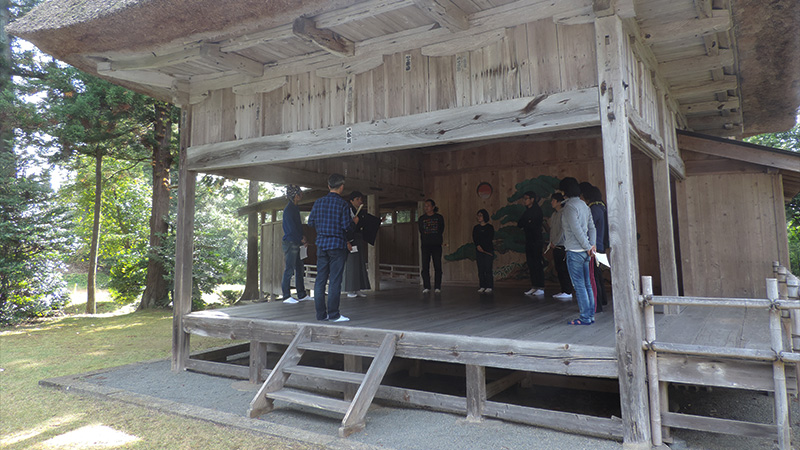“Bush warblers — a Noh stage in a village of ten households” goes a famous haiku written by Keigetsu Omachi, a poet visiting the island during the Taisho period. The poem tells of the vibrant noh culture that the islanders shared that even the smallest of villages in Sado had a noh stage. This program kicks off with the EC Pre Event “Sado Takigi Noh” performance, and on the second day, participants will tour various noh stages on the island. On the third day, try out the art form yourself on the Daizen Shrine Noh Stage and immerse yourself in the art at the pulse of Sado Island.
![]()
Aug. 25 (Thu) approximately 19:00-21:30
1Sado Takigi Noh Theatre[EC Pre Event]
Sado Island has a long history of Noh theater: Zeami, who is credited for perfecting the art form, was exiled to Sado Island, and the first magistrate on Sado was formerly a Noh performer. These days, Sado Island is still home to one third of Japan’s Noh stages. Nowadays one can experience more variety of Noh schools and performance styles on Sado than anywhere else in Japan. We hope you will come and experience Noh by firelight at one of these summer performances.
Aug. 26 (Fri) Noh stage Tour
2Nikuu Shrine
The site where Nikuu Shrine stands used to be a temporary residence, built by the Kamakura Shogunate at the birth of the second daughter of Emperor Juntoku, Imperial Princess Chushi. In honor of the wild irises ("shobu," in Japanese) in full bloom, Emperor Juntoku named the residence Shobuden (literally: iris residence). Dedicated to Princess Chushi, who passed away at the age of eighteen, the shrine buildings were constructed as Nikuu Daimyojin (a shrine) during Emperor Gofukakusa's reign (mid-13th century). Both Shobuden, which enshrines the hair of Princess Chushi, and the graveyard, under management of the Imperial Household Agency, stand within the grounds. There is a Noh stage, too, which has a thatched, hipped roof and is situated, with woods at its back, to the southeast of the main building.
| Address | 〒952-1308232-2 Niku, Sado |
|---|
| Nearest bus stop | 20 minute walk from “Kajimachi Nakahara” stop on the Honsen (Main Line) |
|---|
| Website |
https://www.visitsado.com/en/sp |
|---|
- Located 20 minutes away by car from Aikawa
3An’yoji Haguro Shrine
An'yoji's Haguro Shrine is said to be a shrine to where the god divided from Haguro Shrine, in Yamagata Prefecture, was invited and re-enshrined in 772. It is surrounded by gigantic cedar trees, and the main hall lies in harmony with the surrounding lush woods. Since olden days, in the small village of An'yoji, Noh has been offered in place of Ondeko (demon drumming) in the annual, most important festival. The Noh stage (a Niigata Prefectural Tangible Cultural Asset), with its thatched, hipped-roof, is reputed to have been built in the late Edo Period (19th century). It used to stand across the front path from the main building of the shrine, but around 1909, it was relocated to, and enlarged, on the site where it now lies. The Noh stage at Haguro Shrine is the smallest in Sado, among the ones still in existence.
- Located 25 minutes away by car from Nikuu Shrine
4Shiizaki Suwa Shrine
Shiizaki Suwa Shrine is perched on a hill overlooking Lake Kamo. It was built in 1376, as a shrine to where the god divided from Suwa Taisha, in Nagano Prefecture, was invited and reenshrined. It is, reputedly, a guardian god for the Kujihonma family, the neighbourhood manor's lord. The Noh stage, with its gable-style tiled roof, was built in 1902 (a Niigata Prefectural Tangible Cultural Asset) and hosts the largest number of Noh performances in Sado. Atmospheric bonfire Noh performances are held on Saturdays, from May until early October (excluding August). You can join workshops of Noh and shimai (a simplified version of Noh, which is danced/performed to jiuta songs).
| Address | 〒952-0016724 Harakuro, Sado |
|---|
| Nearest bus stop | 3 minute walk from “Shiizaki Onsen Iriguchi” stop on the Minamisen (South Line) |
|---|
| Website |
https://www.visitsado.com/en/sp |
|---|
- Located 20 minutes away by car from An’yoji Haguro Shrine
5The Honma Family’s Noh Stage
Holding status as the centre of Noh in Sado is the Honma family, present-day grand master and the 18th head of Sado Hosho School. They have been playing a vital role in the promotion and popularization of Noh. Reconstructed in 1885, the Noh stage with its hipped, tiled roof (a Niigata Prefectural Tangible Folk Cultural Asset) has clay pots set under the floor to create good sound effects during performances. It is the most authentic among others in existence in Sado, and the only one that is privately owned. Regular Noh performances are held on the last Sunday in July every year.
| Address | 〒952-3421987 Agata, Sado |
|---|
| TEL | 0259-23-2888(Sado Nohgaku Club & Honma Family Noh Society Secretariat) |
|---|
| Nearest bus stop | 0 minute walk from “Honmake Nohbutai” stop on the Minamisen (South Line) |
|---|
| Website |
https://www.visitsado.com/en/sp |
|---|
- Located 10 minutes away by car from Shiizaki Suwa Shrine
6Ushio Shrine

Ushio Shrine is familiar to locals, which is called "Katagami no Tenno-san," (Gozutenno in Katagami). The reconstructed hall of worship is richly embellished with elaborate sculptures depicting swimming carps and a story related to Emperor Juntoku. It reminds us of the skills and techniques of master carpenters and great craftsmen of the time. The shrine was established in 792 by dividing gods, including Okuninushinomikoto (a god of nation-building, farming, etc.), from Izumo Taisha Shrine in Shimane Prefecture and re-enshrining them here. The sacred tree in front of the hall of worship, estimated at 1,000 years of age, is revered as a cedar that brings fertility and easy delivery. The Noh stage with a hip-and-gable tiled roof in front, and a hipped roof in the back, was reconstructed in 1901. It is a Niigata Prefectural Tangible Cultural Asset and it is one of the four Noh stages in the Kuninaka area where Noh performances were regularly held. The shrine has a long track record of Noh performances. It still keeps Noh masks of Okina (an older man with a white beard) and Sanbaso (the black mask of an older man) as the shrine's treasures, both of which are designated Niigata Prefectural Tangible Cultural Assets. Bonfire Noh performances are held in the evening before the annual festival in June.
| Address | 〒952-01032529 Niibo Katagami, sado |
|---|
| TEL | 0259-22-2237(Ushio Shrine) |
|---|
| Nearest bus stop | 10 minute walk from “Tennoushita” stop on the Minamisen (South Line) |
|---|
| Website |
https://www.visitsado.com/en/sp |
|---|
- Located 3 minutes away by car from The Honma Family’s Noh Stage
Aug. 27 (Sat) 10:00~16:30
7Introduction to Sado’s Noh Theatre (for beginners) [EC Experience Sado Program]
Sado is known for its active noh theatre community and many farmers on Sado also are active noh theatre artists. Come experience the art of noh theatre that has been passed down for generations. After rehearsing in a resident’s home, participants will have the chance to set foot on the Daizen Shrine Noh Stage.
Bus Information
local island buses information
For more information: Niigata Kotsu Sado
Tel. 0259-57-2121(Assistance in Japanese only. 9:00–17:30)
Suggested Lodging (In or around Aikawa and Kuninaka)
Search numerous listings by accommodation type easily on the Sado Official Tourism Information Site!
https://www.visitsado.com/en/stay/
Suggested Eateries (In or around Aikawa, Ryotsu and Kuninaka)
Search numerous listings by cuisine easily on the Sado Official Tourism Information Site!
https://www.visitsado.com/en/meal/






